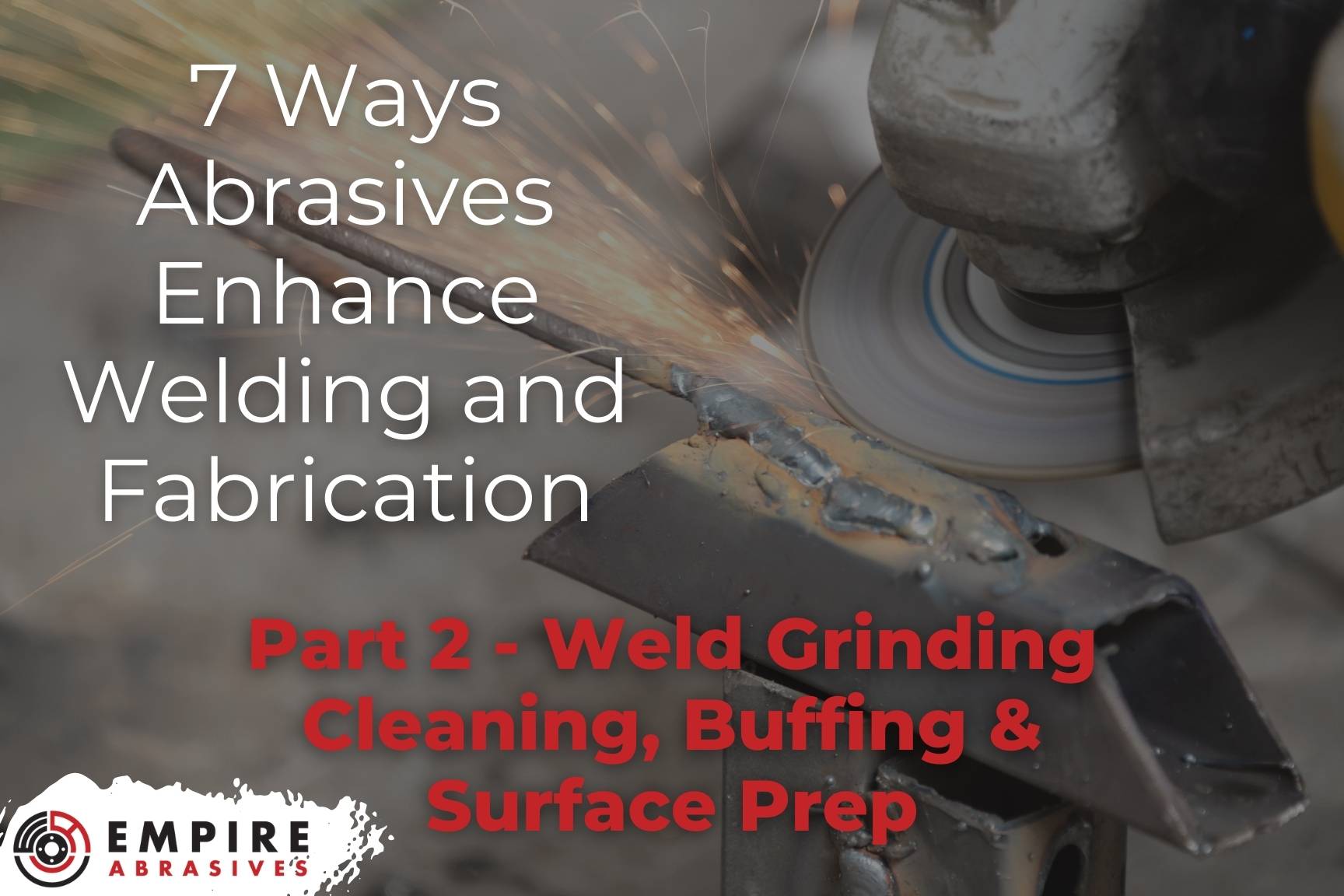
This article is part 2, closing out our two-part series about abrasives for welding and fabrication. In part 1, we discussed using abrasives for cutting, cleaning, and repairing welds of metals throughout the welding process. We’ll finish off this series with a guide to using abrasives for weld grinding, blending, and polishing. If you’d like to catch up on part 1, you can find that in the link above.
ARTICLE CONTENTS
PART 1 - Abrasives for Welding & Fabrication Part 1 - Cutting, Cleaning and Repairing Welds
- Abrasives for Metal Fabrication - Cutting and Notching
- Weld Joint Preparation - Cleaning & Beveling
- Weld Repairs and Fixing Mistakes
- Abrasive Recommendation for New Welders
PART 2 - Abrasives for Weld Grinding Cleaning Buffing & Surface Prep
- Weld Finishing – Weld Cleaning, Grinding, Deburring, Blending and Smoothing
- Grinding Weld Corners or Fillet Welds and Hard to Reach Welds
- Abrasives for Buffing and Polishing
- Abrasives for Coating Surface Preparation
- Recommended Abrasive Products
4. Abrasives for Weld Finishing – Weld Cleaning, Grinding, Deburring, Blending and Smoothing
Depending on the end use, the weld bead may only need to be cleaned to remove any surface defects or contamination. For instance, a welding table or workbench only needs functional welds without any sharp burrs, which might cut your hand if not removed. In other cases, the weld may be ground down and blended into the surrounding base metal.
Post weld defects and surface contamination include weld spatter, slag, surface oxidation or tarnish, discoloration, shallow surface cracks, stuck electrodes tips, burrs, organic contaminants, under cuts, and excess weld material.
Wire brushes, semi-flexible discs, non-woven surface conditioning products, and flap wheels should be sufficient for cleaning a weld.
For welds requiring removal of larger defects like burrs, electrode tips, porosity, cracks and excess weld material, coated abrasive discs or belts, flap discs and bonded abrasive depressed center wheels can be used. Weld cleaners or electropolishers are an electrochemical tool for cleaning welds. They are typically used for cleaning and passivating stainless steel welds.
Excessive reinforcement or too much weld material extending beyond the weld face or root can generate stress concentrations and a weaker weld joint. Excessive reinforcement is considered a defect in most welding codes and grinding off excess material can fix this defect.
To grind a weld bead down and remove welding surface defects, start with as fine a grit size as possible that provides a sufficient metal removal rate to avoid removing too much material and weakening the welded joint. Coarser grits like 24 and 36 grit can generate deep digs and scratches requiring additional abrasive finishing steps for removal.
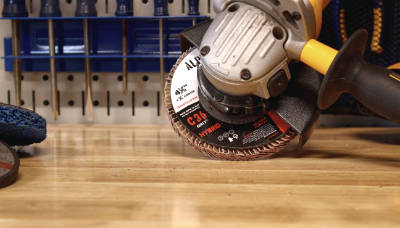
In the worst case, a deep gouge from an aggressive grinding wheel or disc might require spot welding to fill in the cavity. 40 to 60 grit products are typically a good starting point. If a 40 to 60 grit aluminum oxide abrasive product grinds too slowly or wears out quickly, then try ceramic or zirconia abrasives first before moving to a 24 or 36 grit product.
After the weld is ground down, 80 to 120 grit abrasive products can be used to blend the remaining weld into the surrounding workpiece metal. When properly blended, the welded project will look as if it was made from a solid piece of metal and the location of welds should be difficult to identify. If the mill surface finish of the workpieces needs to be matched, then additional smoothing or abrading with fine grit abrasives such as a 120 to 180 grit product can refine and further smooth the surface.
5. Abrasives for Grinding Weld Corners or Fillet Welds and Hard to Reach Welds
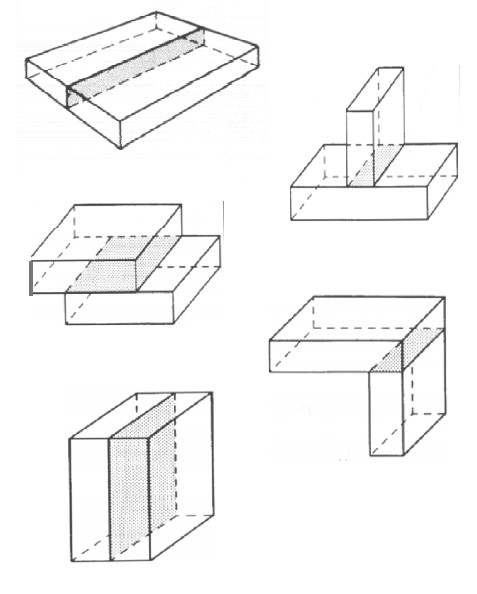
Butt welds are formed between the edges of two surfaces, so the welds are easy to access for cleaning, deburring, smoothing and grinding. Lap and edge welds can also be easily presented to an abrasive disc or wheel. Corner, tee or fillet welds are formed when one workpiece is perpendicular to the other workpiece.
Butt welds are formed between the edges of two surfaces, so the welds are easy to access for cleaning, deburring, smoothing and grinding. Lap and edge welds can also be easily presented to an abrasive disc or wheel. Corner, tee or fillet welds are formed when one workpiece is perpendicular to the other workpiece.
Weld corners can be difficult to reach with abrasive discs, semi-flexible discs and grinding wheels. These products are great for cleaning welds, grinding a weld bead flat and blending welds on flat surfaces, but not so much on corners, pockets and hard to reach areas. The edge of a depressed center grinding wheel might reach into and grind out a corner weld, but overgrinding, undercutting and digs into the sides are likely to occur. Narrow mounted flap wheels, narrow abrasive belts, cartridge rolls, cross pads, spiral bands and other abrasives and tools designed to abrade hard to reach places are the best option.
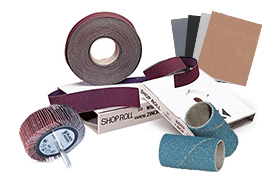
Abrasives with a level of flexibility such as mounted flap wheels, cross pads and nonwovens can conform to the shape being ground, which allows these flexible abrasive products to clean up weld corners.
For basic weld cleanup such as removal of slag, spatter and discoloration or oxidation a wire wheel mounted on an angle grinder will also work.
For small jobs with a limited amount for corner welds, a slower, manual approach using hand files, abrasive sheets, shop rolls and nonwoven hand pads to clean or finish a weld corner might be sufficient. While this results in slower processes, the upside is additional power tools like file belt sanders or die grinders do not need to be purchased.
When the weld bead in the corner needs to be flattened and then blended, narrow abrasive belts, spiral bands or cartridge rolls and flap discs might do the trick. If one end of the welded corner is open and accessible, then spiral bands and cartridge rolls mounted on a pencil or die grinder can clean up or grind a corner weld bead. Mounted points and carbide burrs on a die grinder will also work.
On a corner with a large weld bead, a narrow abrasive belt on a file belt sander could reach into a grind the bead. The desired finished radius of the fillet must be larger than the diameter of the spiral band, cartridge roll or contact wheel on the file belt sander, so this approach is more feasible on larger constructions. An abrasive belt has much more abrasive surface area, so they will last much longer than mounted points, carbide burrs, spiral bands or cartridge rolls. Grinding and finishing a long corner weld would require many mounted points, carbide burrs, spiral bands or cartridge rolls.
On a corner weld where both ends are open, the edge of certain flap discs mounted on an angle grinder can clean and to some extent grind the corner beads. Flap discs capable of grinding into corners have some of the abrasive flaps exposed or extending slightly beyond the fiberglass backing. A coarse grit flap disc can overgrind the weld or create digs outside the weld, so start grinding gently or with light pressure using a finer grit flap disc.
*Basic weld joint types image source - U.S. NRC
6. Abrasives for Buffing and Polishing
Stainless steel, aluminum and bronze fabrications are often polished and buffed to produce a mirror like surface finish. These metals are corrosion resistant in many environments, so they do not require additional protective coatings.
A series of abrasive products increasing in fineness or grit size are used to produce a polished surface. Buffing is used to produce a brilliant, mirror-like surface appearance.
Steel alloy welds, which are going to be electroplated, will most likely need to be refined to polished or buffed finish to produce the expected brilliance and shine in the chrome or nickel-plated surfaces. Since electroplated layers are very thin, the appearance of the plated surface is dependent on the initial surface finish. If a sanded or brushed surface with a protective plating layer is the goal, then polishing is not necessary. Anodized aluminum weld surfaces would require the same approach.
Before a welded project is buffed to produce a lustrous or polished surface, finer grit abrasive belts, abrasive discs, and nonwoven abrasive can be used to remove or blend out the coarse scratches from previous weld grinding, blending and smoothing steps. If the weld was initially flattened with a 40-grit flap disc, then you might want to refine the scratches with 80 or 120 grit flap discs or fiber discs.
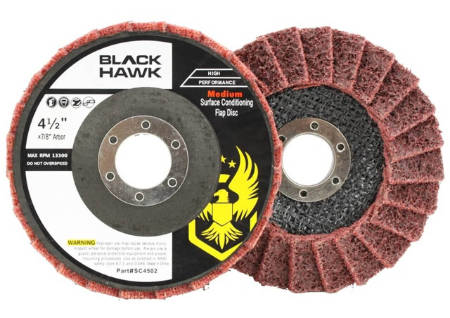
Next, the surface can be further smoothed with finer grit coated abrasives, non woven discs or non woven surface conditioning flap discs. For instance, the coarse scratches could be removed using a medium (120 - 180 Grit) nonwoven flap disc followed by a fine (280 - 360 Grit) nonwoven flap disc.
On polishing aluminum welds, finishing with a fine grit surface preparation wheel followed by an ultra-fine surface prep disc should prepare the surface for buffing. Although, the finish from the ultrafine nonwoven wheel might be acceptable depending on the specific finish or appearance.
“Polishing belts'' or finer (150 to 600 grit) ranges of abrasive belts are frequently used in a “polishing” step before buffing a part with a buffing compound. Nonwoven belts are also used to remove scratches and swirls.
In some cases, a polishing abrasive belt or non woven wheel or belt are used to produce a satin or brushed finish like you would find on stainless steel refrigerator doors. A satin finish is often a better choice if your project is going to be handled or touched because fingerprints and smudge marks are more visible on highly buffed, shiny metal surfaces.
Satin or linear finishes can also be produced on welded projects using abrasive drum sleeves or abrasive flap wheels for blending followed by interleaved and nonwoven flapwheels for scratch removal. These drum shaped abrasive products are used on surface conditioning power tools, which are also known as linear or contour surfacing tools and drum grinders or sanders.
Buffs or buffing wheels, buffing drums, and felt polishing discs are used in conjunction with abrasive buffing compounds to produce polished or mirror finishes on metal surfaces.
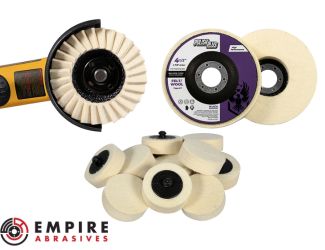
Buffing compounds contain abrasive grain is a greasy or waxy stick. They are available in a variety of grit sizes or grades. Coarser grade “cut buffing” compounds are used to remove the very fine scratches left from disc, belt or non woven polishing or smoothing followed by final buffing with “color buffing” compound containing extremely fine abrasive grains to produce a bright mirror finish.
On a large flat welded project, buffing drums or felt polishing discs or felt flap discs make the most sense. Buffing wheels are typically run on benchtop buffing machines for metal objects that can be handheld and presented to the wheel, which might be useful if your welded project can be held in your hand.
7. Abrasives for Coating Surface Preparation
Paint and coating is the final step in many welding projects whether it is repairing a car body, building a welded chair for your patio, welding a bike frame from high strength steel tubing or making a welded shelve for your living room.
For welded projects made from steel, a protective coating or paint layer is required to prevent rust as well as improve the overall general appearance. If your welding project is constructed of stainless steel, titanium or aluminum, then a satin or polished finish should be fine for most applications. Even aluminum would benefit from a protective coating if the project will be used in a wet or salty exterior application.
While electroplated coatings may require an exceptionally smooth or polished surface finish for a mirror-like appearance, paint, powder coatings and high build coating do not require or benefit from a super smooth surface. In fact, a rougher surface can provide undercuts allowing a coating to better adhere to a surface. Thicker powder coatings and high build liner materials don’t really need a highly smooth surface. Just like making a sound welds or strong adhesive bond, the most important aspect in assuring that your paint or coating adheres to a surface is proper cleaning and surface preparation, which brings us back to where we started.
A wide variety of abrasives are useful for cleaning and surface preparation joint surface before painting including abrasive fibre discs, abrasive belts, wire brushes, flap discs, and nonwoven abrasive products.
Summary & Where can I find abrasive products for my welding project?
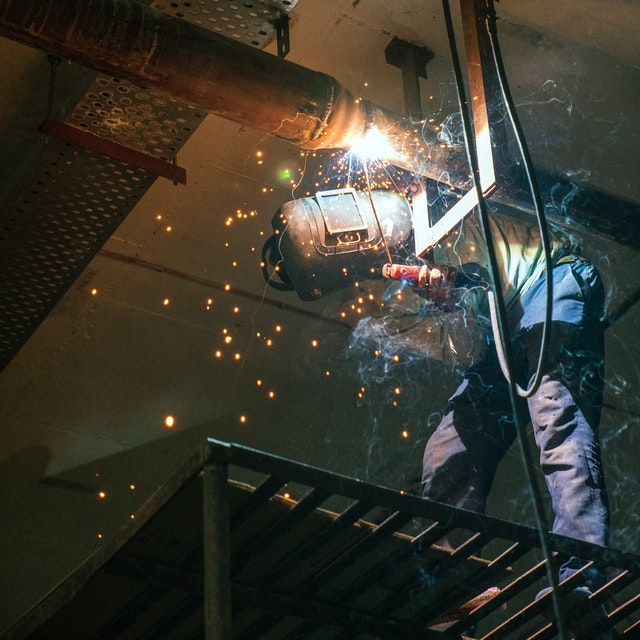
Abrasives are important in fabrication and welding because abrasive grinding, cutting and finishing is required in every step of the component making and joining process.
To use these abrasive products effectively and safely in fabrication and welding, all operating instructions and speed limits of abrasive products, power hand tools and grinding machinery should be followed. Abrasives and grinding reduce weld and joining costs by reducing the time required to fabricate, prepare joints surfaces, repair weld defects, and finish completed welds.
Abrasives are indispensable and found in the toolboxes of most welders and fabricators. If you are just getting into welding or are a seasoned welder and you are asking, “ Where can I find abrasive products for my welding project?" - then here is a list of abrasives and tools you should have in or add to your toolbox depending on the details of your projects:
- Chop Saw Wheels - For cutting parts from bar, tube, angle iron and other metal stock.
- Cut-off or Cutting Wheels – For cutting shapes or parts to be weld, beveling, and cutting apart bad welds.
- Depressed Center Grinding Wheels - For cleaning and surface preparation before, during and after welding, beveling joints before welding and grinding out porosity or cracks in bad welds.
- Flap Discs or Resin Fiber Discs - For cleaning and surface preparation before and after welding as well as smoothing, blending and finishing welds.
- Narrow abrasive belts or Specialty Abrasives (Spiral Wheels, Flap Wheels, etc.) – For cleaning, grinding and blending corners in fillet welds.
- Hole Saws and Metal Saw Blades – For notching tube and making holes in sheet or plate
- Nonwoven Abrasives or Wire Wheels and Brushes - For cleaning and surface preparation before, during and after welding as well as smoothing, polishing, deburring and refining finishes.
- Buffing Discs or Wheels – For polishing weld projects that require bright or mirror finishes.
The specific abrasive product to select also depends on the metal alloy of the weld fabrication. The best abrasive product for a hard alloy steel can be quite different for an abrasive optimized for soft aluminum. Empire Abrasives product catalog provides additional details on specific products for aluminum as well as hard to grind stainless steels and alloys steels.
